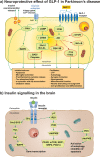Incretin and insulin signaling as novel therapeutic targets for Alzheimer's and Parkinson's disease
- PMID: 36258018
- PMCID: PMC9812772
- DOI: 10.1038/s41380-022-01792-4
Incretin and insulin signaling as novel therapeutic targets for Alzheimer's and Parkinson's disease
Abstract
Despite an ever-growing prevalence and increasing economic burden of Alzheimer's disease (AD) and Parkinson's disease (PD), recent advances in drug development have only resulted in minimally effective treatment. In AD, along with amyloid and tau phosphorylation, there is an associated increase in inflammation/glial activation, a decrease in synaptic function, an increase in astrocyte activation, and a state of insulin resistance. In PD, along with α-synuclein accumulation, there is associated inflammation, synaptic dysfunction, dopaminergic neuronal loss, and some data to suggest insulin resistance. Therapeutic strategies for neurodegenerative disorders have commonly targeted individual pathological processes. An effective treatment might require either utilization of multiple drugs which target the individual pathological processes which underlie the neurodegenerative disease or the use of a single agent which could influence multiple pathological processes. Insulin and incretins are compounds with multiple effects on neurodegenerative processes. Preclinical studies have demonstrated that GLP-1 receptor agonists reduce neuroinflammation, reduce tau phosphorylation, reduce amyloid deposition, increase synaptic function, and improve memory formation. Incretin mimetics may act through the restoration of insulin signaling pathways, inducing further neuroprotective effects. Currently, phase 2 and phase 3 trials are underway in AD and PD populations. Here, we provide a comprehensive review of the therapeutic potential of incretin mimetics and insulin in AD and PD.
© 2022. The Author(s).
Conflict of interest statement
The authors declare no competing interests.
Figures


References
-
- Aarsland D, Pahlhagen S, Ballard CG, Ehrt U, Svenningsson P. Depression in Parkinson disease–epidemiology, mechanisms and management. Nat Rev Neurol. 2011;8:35–47. - PubMed
-
- Alzheimer’s Disease International. World Alzheimer Report 2018: The state of the art of dementia research: New frontiers. Alzheimer’s Disease International: London, 2018.
-
- Masters CL, Bateman R, Blennow K, Rowe CC, Sperling RA, Cummings JL. Alzheimer’s disease. Nat Rev Dis Prim. 2015;1:15056. - PubMed
Publication types
MeSH terms
Substances
Grants and funding
LinkOut - more resources
Full Text Sources
Medical

